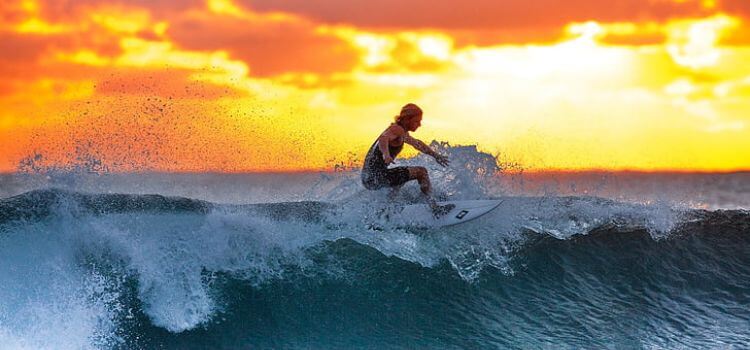As an Amazon Associate, I earn from qualifying purchases
Paddleboards are longer, wider, and have increased volume to stay afloat even with additional weight, while surfboards are agile, lightweight, and thin for riding waves at high speeds. Paddle board vs surfboard, the main difference lies in their design and purpose.
Paddleboards are ideal for beginners and offer stability and ease of use, making it easier to catch and ride waves. Surfboards are designed for experienced surfers who want to maneuver quickly and ride waves at high speeds. Whether you choose a paddleboard or a surfboard depends on your skill level, fitness, and the type of water activities you want to engage in.
Characteristics And Design Differences

Paddle boards and surfboards have distinct characteristics and design differences. Paddle boards are longer, wider, and have increased volume to stay afloat with additional weight, while surfboards are agile, lightweight, and thin to ride waves effectively.
Size And Shape
A significant difference between paddle boards and surfboards lies in their size and shape, particularly when considering the dynamics of paddle board vs surfboard. Surfboards are designed to be agile, lightweight, and thin, allowing surfers to maneuver through the water and ride waves effectively. On the other hand, paddle boards have a longer and wider profile, making them more stable on the water. The increased volume and width provide better balance and support for paddle board users, especially when standing or performing various activities like yoga or fishing.
Related: What Size Surfboard Do You Need?
Volume And Buoyancy
The volume and buoyancy of a board play a crucial role in its performance in the water. Surfboards are designed to have low volume, allowing them to be more maneuverable in the waves. Conversely, paddle boards have a higher volume to ensure buoyancy. The increased volume helps the paddle board stay afloat, even with additional weight on top, such as a paddler or equipment. This higher buoyancy makes paddle boards more suitable for activities that require stability, such as touring or carrying extra gear.
Stability And Maneuverability
The stability and maneuverability of a board are essential factors to consider when choosing between a paddle board and surfboard. Surfboards offer excellent maneuverability due to their smaller size and narrower width, making them ideal for riding waves and performing tricks. Paddle boards, with their wider and longer profiles, provide greater stability on the water. This stability allows paddlers to comfortably stand on the board and engage in activities like paddling for longer distances or practicing yoga.
The trade-off for this added stability is a slight decrease in maneuverability compared to surfboards. Paddle boards may require more effort and technique to make quick turns or perform advanced maneuvers in the waves. However, for those looking for a relaxing and stable experience on the water, paddle boards are a fantastic choice.
Performance And Skill Requirements

When it comes to choosing between a paddle board and a surfboard, understanding the differences in performance and skill requirements is essential. Each board offers a unique experience and requires distinct abilities to navigate the water. Let’s explore the various aspects of performance and skill required for both paddle boarding and surfing.
Riding Waves
Riding waves is the ultimate thrill for both paddle boarders and surfers. However, the approach and technique differ significantly between the two. When stand-up paddle boarding, catching a wave is considerably easier compared to surfing. Since you are already standing on the board, you have an advantage in maintaining balance and stability. Additionally, you have the freedom to start from either side of the wave, enhancing your ability to ride along with its natural movement.
Paddling And Balance
Paddling and balance are crucial skills needed for both paddle boarding and surfing. However, the techniques used on each board differ. Paddle boards are designed with stability in mind, allowing you to comfortably stand and paddle across the water. Maintaining balance on a paddle board is generally easier due to its wider shape and larger volume.
When it comes to Paddle Board vs Surfboard, Paddle boards offer a more stable platform for beginners to learn the ropes. On the other hand, surfing requires more agility and core strength to maintain balance while riding waves on a narrower surfboard. The ability to paddle efficiently and maintain balance plays a significant role in your overall performance on either board.
Learning Curve
The learning curve for paddle boarding and surfing can vary depending on individual skill and experience. Paddle boarding tends to have a shorter learning curve, especially for beginners. The stability provided by paddle boards makes it easier to adapt and learn the basics quickly. In contrast, surfing requires more time and practice to develop the necessary skills for wave riding. Mastering the art of catching waves, proper positioning on the board, and executing maneuvers on a surfboard demands time, patience, and dedication.

In conclusion, while both paddle boarding and surfing offer exciting water sports experiences, there are distinct differences in the performance and skill requirements. Paddle boarding provides a more accessible entry point, with easier wave riding and heightened stability. On the other hand, surfing demands a higher level of agility and balance, but offers unparalleled thrills for those willing to put in the effort. Ultimately, the choice between paddle boarding and surfing depends on your personal preferences and skill level.
Related: How to Stand Up on a Surfboard
Frequently Asked Questions For Paddle Board Vs Surfboard
Is It Easier To Surf Or Paddle Board?
Stand-up paddle boarding is easier than surfing because you’re already standing on the board, making it easier to catch and ride waves. You can start from either side of the wave and go with its natural movement. You can even try paddleboarding with a surfboard if you already have one, but it might be a bit trickier due to balance.
Paddleboards are longer and wider than surfboards, designed to provide stability and floatation. Sitting on a paddle board is also possible and a great way to relax while on the water.
Can I Use A Surfboard As A Paddle Board?
Yes, you can use a surfboard as a paddle board, but it may be more challenging due to the surfboard’s design. Balancing on a surfboard while paddleboarding can be trickier than using a traditional paddleboard.
What Is The Difference Between Paddle Board And Surfboard?
Surfboards are agile, lightweight, and thin for fast wave riding, while paddle boards are longer, wider, and have more volume to stay afloat with added weight. Paddleboarding on a surfboard is possible but trickier, and sitting on a paddle board is also allowed.
Paddle boards are beginner-friendly, while surfboards offer moderate versatility.
Is It Ok To Sit On A Paddle Board?
Yes, it is absolutely okay to sit on a paddle board. Sitting on a paddle board is a great way to relax and enjoy your time on the water. Paddle boards are designed to be stable, so you can comfortably sit and paddle at your own pace.
Conclusion
Overall, when comparing paddle boards and surfboards, it is clear that each has its own unique characteristics and purposes. Paddle boards are designed for stability and ease of use, making them ideal for beginners and those looking for a relaxing experience on the water.
On the other hand, surfboards are built for agility and speed, catering to the thrill-seeking surfers who want to ride the waves with precision. Understanding the key differences between these two water sports is important in choosing the right one for your needs and preferences.
Whether you’re looking for a tranquil paddleboarding session or an exhilarating surfing adventure, both options offer enjoyable and fulfilling experiences on the water.
As an Amazon Associate, I earn from qualifying purchases

